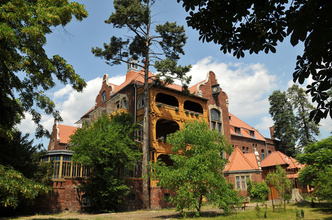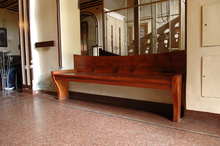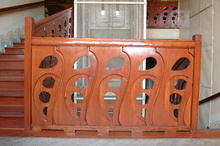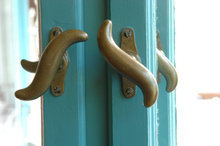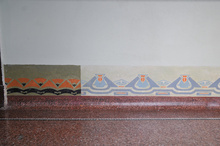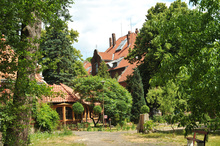Haus für Sozialhilfe in Trzebiechów - Henry van de Velde
Of course there are plenty, frequently one of a kind and unique … in Poland. The biggest tourist attraction of Zielona Góra County hides in the interiors of the Nursing Home in Trzebiechów. It is neither a joke nor a mistake. Since 2003 the Nursing Home has been visited by visitors from all over Europe. This is how it all began…
In 1903, on the initiative of the Duchess Maria Aleksandra von Reuss, who was the owner of Trzebiechów land, the construction of a physiotherapeutic-dietetic sanatorium started. The two buildings – the sanatorium building itself and the so-called ‘doctor’s house’ - were designed by Max Schündler, an architect from Zwickau. Most probably disappointed with the conventional mass of the buildings designed in the then trendy North-German Neo-Renaissance style, the Duchess called on Henry van de Velde ‘for help’. He was then employed as a craft and small-scale industry advisor to the Grand Duke Wilhelm Ernest in Weimar. She consulted the architectural designs with the artist and entrusted him with the designing and furnishing of the interiors of the sanatorium.
Let us recall the person of Henry van de Velde. Born in Antwerp in 1863, Henry van de Velde was one of the main originators and theorists of Secession. He was a universal artist. During his lifetime (he died in 1957 in Switzerland) he was involved not only in architectural designs but also in handicraft. He designed furniture, glaziery, carpentry, pottery, jewellery, chandeliers, applique work, graphics, lettering, posters, industrial packaging, artistic upholstery, and designs of clothing fabrics. He laid dominant emphasis on the importance of the line and contour, subjecting ornamentation to the perfection of the overall construction. In his autobiography ‘The Story of My Life’ he made no mention of Trzebiechów. As a result, his designs for the sanatorium have remained unknown to researchers of his creative output.
Over the years, the sanatorium has had its ups and downs. Since 1974 it has housed a nursing home and in 1999 it became an organizational unit of Zielona Góra County.
For years, a German Erwin Bockhorn von der Bank, a grandson of the last pre-war director of the sanatorium, had made numerous visits to Trzebiechów. It was not until 2002, however, that among his grandfather’s letters he found a few signed by Henry van de Velde. In their mutual correspondence they made reference to Trzebiechów. That intrigued E. Bockhorn. He reported his sensational findings to the Provincial Coservator of Monuments in Zielona Góra. Soon art historians undertook research, which proved beyond any doubt that the Nursing Home boasts original works by the Belgian artist. These findings were officially announced at an international conference ‘Henry van de Velde – Arts Without Frontiers’, which was held in Trzebiechów in October 2003 under the honorary patronage and with the personal participation of His Excellency the Ambassador of the Kingdom of Belgium to Warsaw, Mr Bruno Neve de Mèvergnies.
The year 2004 marked the beginning of the renovation work, which has been carried out with the purpose of restoring former splendour to the estate. Thanks to the so-called ‘exposures’ one can now admire the original colouring of the interiors as designed by the eminent Belgian artist. The so-called social rooms for Ladies and Gentlemen and the billiard room have been restored. In 2006 the window carpentry in both buildings and in the connecting passage has been renovated, thus restoring it to its original colouring.
Further research, conducted by prof. dr hab. Dariusz Markowski, a conservator of The Institute of Monument Studies and Conservation at the Mikołaj Kopernik University of Toruń exposed a unique set of seven ornamental motifs – the richest of its kind - adorning the interiors. As prof. Markowski said: ‘The interiors of the sanatorium in Trzebiechów are absolutely admirable for their colouring, the contouring of the ornamentation and their detail. The quantity and the high quality of the exposed painting decorations make the Trzebiechów monument of unique meaning to the whole of the world culture.’
In September of 2007 – on the 50th anniversary of the Artist’s death – another conference ‘Henry van de Velde – Art Without Borders’ was held in Trzebiechów. It was organized under the honorary patronage and with the personal participation of His Excellency the Ambassador of the Kingdom of Belgium to Poland, Mr Jan Luykx. Mr Ambassador was accompanied by His Wife, Mrs Raka Kahn. At the conference, the progress of the renovation work in the former sanatorium was presented. It was another occasion for art conservators from Poland and Germany to express their opinions. Also in Trzebiechów the book ‘Henry van de Velde in Poland’, published by the German Forum for the Culture of Central and Eastern Europe in Potsdam, had its premiere.
It is worth coming to Trzebiechów to admire the pearl of Lubuskie Secession in its sheer beauty. This is the only place in Poland where one can see original works of art by Henry van de Velde. You are also most welcome to visit the www.henryvandevelde.pl site, which will give you a taste of what can be seen live in reality. This website includes panoramic and one-dimension photos as well as plenty of information about the artist, his achievements and the building itself. The site is available in 4 languages.
There are three very attractive museums in the county, which present completely different aspects of the past.
Images
scroll top« Previous 1 2
Trzebiechów Commune
Trzebiechów Commune covers the area of 81 km2 and is one of the smallest in Zielona Góra County.

